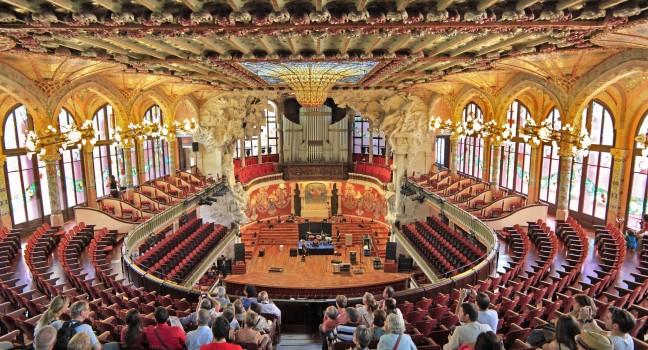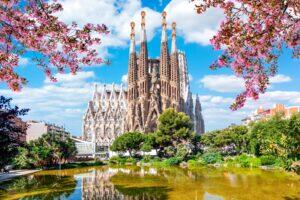Fodor's Expert Review Palau de la Música Catalana

On Carrer Amadeus Vives, just off Via Laietana, a 10-minute walk from Plaça de Catalunya, is one of the world's most extraordinary music halls, a flamboyant tour de force designed in 1908 by Lluís Domènech i Montaner. Its sponsors, the Orfeó Català musical society, wanted it to celebrate the importance of music in Catalan culture and the life of its ordinary people (as opposed to the Liceu opera house, with its Castilian-speaking, monarchist, upper-class patrons, and its music from elsewhere), but the Palau turned out to be anything but commonplace. It and the Liceu were, for many decades, opposing crosstown forces in Barcelona's musical as well as philosophical discourse. If you can't fit a performance into your itinerary, you owe it to yourself to at least take a tour of this amazing building.
The exterior is a remarkable riot of color and form. The Miquel Blay sculptural group over the corner of Amadeu Vives and Sant Pere Més Alt is a hymn in stone to Catalonia's popular... READ MORE
On Carrer Amadeus Vives, just off Via Laietana, a 10-minute walk from Plaça de Catalunya, is one of the world's most extraordinary music halls, a flamboyant tour de force designed in 1908 by Lluís Domènech i Montaner. Its sponsors, the Orfeó Català musical society, wanted it to celebrate the importance of music in Catalan culture and the life of its ordinary people (as opposed to the Liceu opera house, with its Castilian-speaking, monarchist, upper-class patrons, and its music from elsewhere), but the Palau turned out to be anything but commonplace. It and the Liceu were, for many decades, opposing crosstown forces in Barcelona's musical as well as philosophical discourse. If you can't fit a performance into your itinerary, you owe it to yourself to at least take a tour of this amazing building.
The exterior is a remarkable riot of color and form. The Miquel Blay sculptural group over the corner of Amadeu Vives and Sant Pere Més Alt is a hymn in stone to Catalonia's popular traditions, with hardly a note left unsung: St. George the dragon-slayer (at the top), women and children at play and work, fishermen with oars over their shoulders—a panoply of everyday life.
Inside, the decor of the Palau assaults your senses before the first note of music is ever played. Wagner's Valkyries burst from the right side of the stage over a heavy-browed bust of Beethoven; Catalonia's popular music is represented by the graceful maidens of Lluís Millet's song Flors de Maig (Flowers of May) on the left. Overhead, an inverted stained-glass cupola seems to channel the divine gift of music straight from heaven. Painted rosettes and giant peacock feathers adorn the walls and columns, and, across the entire back wall of the stage, is a relief of muse-like Art Nouveau musicians in costume. The visuals alone make music sound different here, be it a chamber orchestra, a renowned piano soloist, a gospel choir, or an Afro-Cuban combo.
A variety of tours are available. The standard guided tour in English takes place at 10 am and 3 pm, and you can add a 20-minute live piano or organ recital on select dates (check availability and book online in advance). Self-guided audio tours, downloaded to your personal device, are €14.
READ LESS








